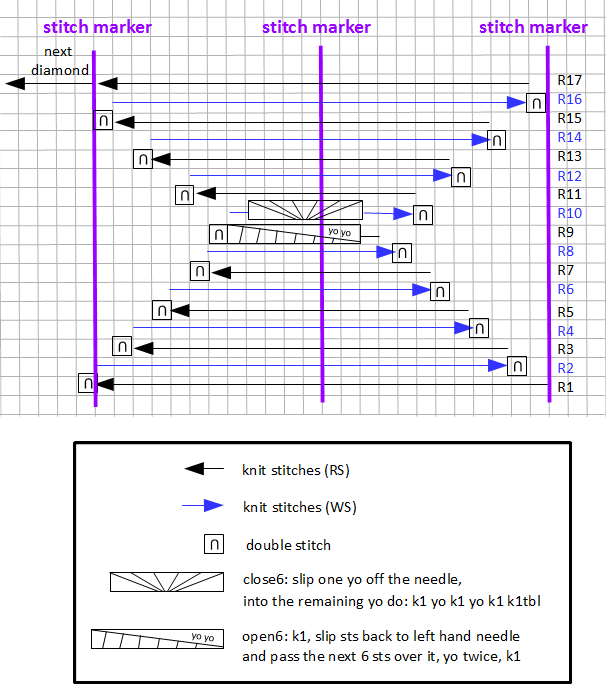This scarf is an example of modular knitting. It's made out of diamond-shaped modules form a longish rhomboid. To add a little spice there is a hole in the middle of each diamond.
As with most examples of modular knitting, it's a great way to show off variegated yarn.

This work by Knitting and so on is licensed under a Creative Commons Attribution-NonCommercial-ShareAlike 4.0 International License.

A Danish version of this pattern can be found here at strikkeglad.dk. Thank you, Marianne Holmen for this translation (and many others :) ... a list of all translations of my patterns can be found in this blogpost.
Materials
- 140 grams of fingering weight yarn
- 3.25mm needles
- 11 sts markers
- a tapestry needle to weave in ends
Abbreviations and Special Stitches
- open6 = k1, slip st back to left hand needle, and pass the next 6 sts over this st, yo twice, k1
- close6 = slip one yo off the needle, into the remaining yo do: k1 yo k1 yo k1 k1tbl
- Short rows with double stitches (German short rows, t+p): when you turn, bring yarn to the front and pull it back so that a sort of "double-stitch" is created, then knit back as usual - when you have to knit the double-stitch, be careful to knit it as one stitch (see also https://www.youtube.com/watch?v=P6n561SMZXQ); this method has the advantage the no picking up of stitches is necessary. In the pattern, this stitch will be called t+p (turn and pull).
- Knitted Cast-On: http://youtu.be/IzVy8fRfOw0
- Stretchy Bind-Off: http://youtu.be/cGHItYwr1us
Construction
The scarf is knitted in diamond-shaped modules. Picture 1 shows the construction of the scarf and how the diamonds add up to form a parallelogram - the yellow arrows indicate the order in which the diamonds are knitted. (Click on the picture to enlarge it.)
 |
| Picture 1: Construction of Queen of Diamonds Scarf |
All diamonds marked with "n" (normal diamonds) are knitted as follows:
R1: k25 t+p
R2: k23 t+p
R3: k21 t+p
R4: k19 t+p
R5: k17 t+p
R6: k15 t+p
R7: k13 t+p
R8: k11 t+p
R9: k1 open6 k1
R10: k1 close6 k3
R11: k11 t+p
R12: k13 t+p
R13: k15 t+p
R14: k17 t+p
R15: k19 t+p
R16: k21 t+p
R17: k23 t+p -> don't turn, but start next diamond
Picture 2 shows a diagram of how one diamond is knitted. The pattern is written in a way that stitch markers are not necessary, but I found it helpful to use them anyway to see easily where the boundaries and the middle of the current diamond are.
Please note that in row 9 - when starting the hole - the stitch marker has to be removed and in row 10 - when the hole is closed - it has to be placed again.
 |
| Picture 2: How to knit one Diamond |
Depending on where you are in the knitting process, the directions for the first and last rows might be slightly different, i.e. they are variations of the diamonds marked with "n". These diamonds are marked with numbers.
Instructions
The numbers in brackets refer to the numbers in circles in picture 1.
Layer 1
Diamond (1):
CO 24 with a knitted cast-on
Row 1: k24
Row 2: sl k22 t+p
knit rows 3-17 of normal (n)-diamond
Layer 2
Diamond (2):
CO12 with knitted cast-on,
Row 1: k12 pm k13 t+p
Knit rows 2 to 17 of normal (n)-diamond
Diamond (3):
k12, CO12 with knitted cast-on
Row 1: k12 pm k13 t+p
Knit rows 2 to 17 of normal (n)-diamond
Layer 3
Diamond (4):
don't turn, k12 (i.e. to end)
CO12 with knitted cast-on
Row 1: k12 pm k13 t+p
Knit rows 2 to 17 of normal (n)-diamond
Knit one (n)-diamond
Diamond (5):
don't turn, k12 (i.e. to end)
CO12 with knitted cast-on
Row 1: k12 pm k13 t+p
Knit rows 2 to 16 of normal (n)-diamond
Layer 4
Knit a diamond (2)
Knit two (n)-diamonds
Knit a diamond (3)
Layer 5
Knit a diamond (4)
Knit three (n)-diamonds
Knit a diamond (5)
Layer 6
Knit a diamond (2)
Knit four (n)-diamonds
Diamond (6):
don't turn, k12 (i.e. to end)
CO12 with knitted cast-on
Row 1: k12 pm k13 t+p
Knit rows 2 to 16 of normal (n)-diamond
Row 17: BO12
Layer 7
Diamond (7):
Row 1: k13 t+p
Knit rows 2 to 16 of normal (n)-diamond
Row 17: BO12, k12
Knit four (n)-diamonds
Knit a diamond (5)
Layer 8
Knit a diamond (2)
Knit four (n)-diamonds
Knit a diamond (8)
Diamond (8)
Knit rows 1 to 17 of normal (n)-diamond
Row 18: BO12
Repeat Layers 7 and 8 until your scarf feels long enough - except for the end.
Layer 9
Knit a diamond (7)
Knit four (n)-diamonds
Diamond (9):
don't turn, k12 (i.e. to end)
CO12 with knitted cast-on
Row 1: k12 pm k13 t+p
Knit rows 2 to 16 of normal (n)-diamond
Row 17: BO12
Layer 10
Diamond (10):
Knit rows 1-16 of normal (n)-diamond
Row 17: BO12, k12
Knit three (n)-diamonds
Knit a diamond (8)
Layer 11
Knit a diamond (7)
Knit two (n)-diamonds
Diamond (11)
Knit rows 1 to 16 of normal (n)-diamond
Row 17: BO12
Layer 12
Knit a diamond (10)
Knit one (n)-diamond
Knit a diamond (8)
Layer 13
Knit a diamond (7)
Knit a diamond (11)
Layer 14
Diamond (12)
Knit rows 1-16 of normal (n)-diamond
BO all stitches
Weave in ends and block.




































